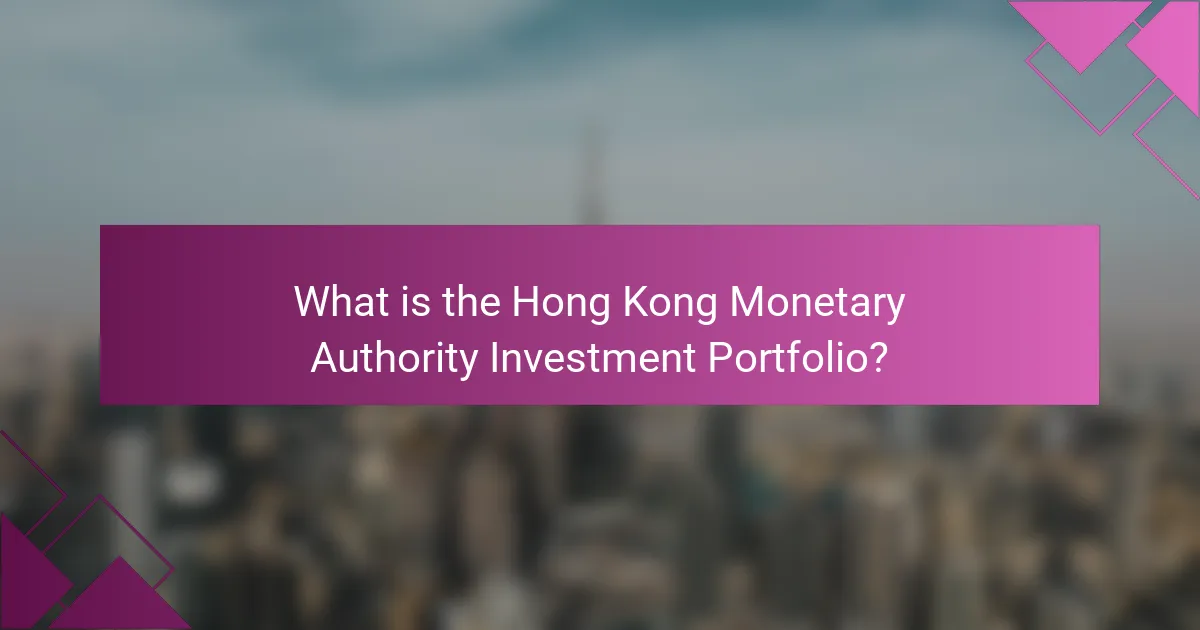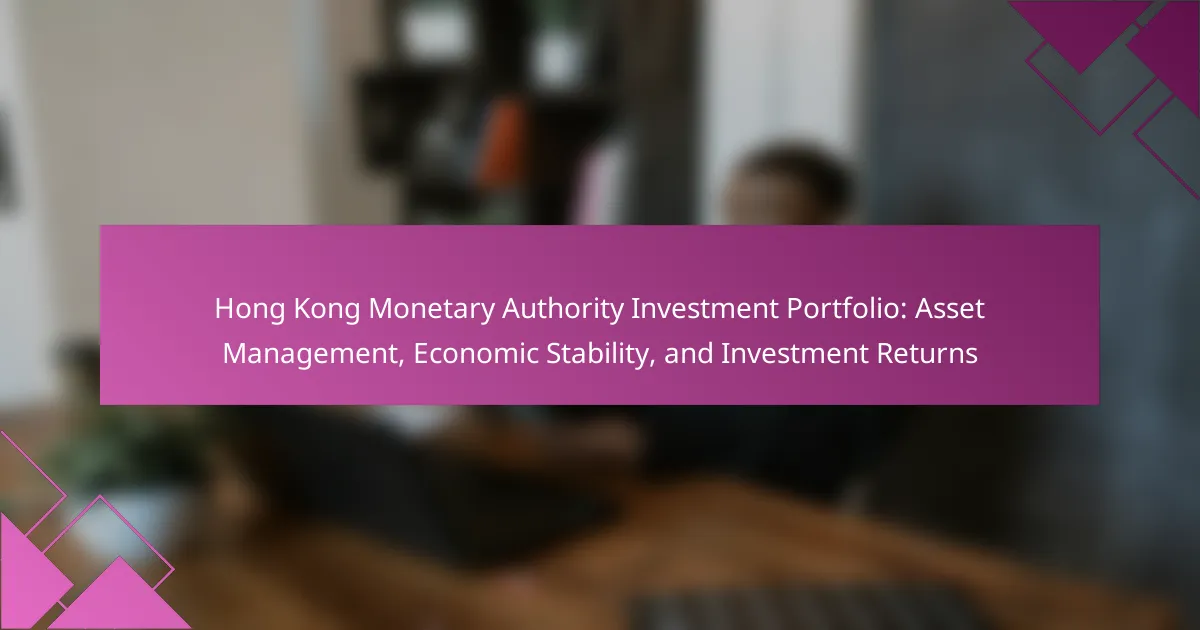
What is the Hong Kong Monetary Authority Investment Portfolio?
The Hong Kong Monetary Authority Investment Portfolio is the investment portfolio managed by the Hong Kong Monetary Authority (HKMA). This portfolio aims to ensure the stability of Hong Kong’s monetary and financial systems. It primarily consists of foreign exchange reserves and other financial assets. The HKMA invests in a diversified range of assets, including government bonds and equities. The portfolio is designed to achieve long-term investment returns while maintaining liquidity and capital preservation. As of 2023, the total value of the portfolio is approximately HKD 4.5 trillion. This figure reflects the HKMA’s commitment to prudent investment strategies. The portfolio plays a critical role in supporting Hong Kong’s economic stability.
How does the Hong Kong Monetary Authority manage its investment portfolio?
The Hong Kong Monetary Authority manages its investment portfolio through a structured investment strategy. This strategy focuses on maintaining the stability of the Hong Kong dollar and safeguarding the Exchange Fund. The investment portfolio includes various asset classes such as equities, fixed income, and foreign currencies. The Authority employs a risk management framework to assess and mitigate investment risks. Regular reviews of market conditions inform adjustments to the portfolio. The Authority aims to achieve a balance between risk and return. Historical performance data demonstrates the effectiveness of its investment approach. The Authority’s transparency in reporting further enhances trust in its management practices.
What are the key components of the investment portfolio?
The key components of an investment portfolio include asset allocation, diversification, risk tolerance, and investment strategy. Asset allocation refers to the distribution of investments across various asset classes, such as stocks, bonds, and cash. Diversification involves spreading investments within each asset class to reduce risk. Risk tolerance is the investor’s ability to withstand market fluctuations and potential losses. Investment strategy outlines the approach for selecting and managing assets based on financial goals and market conditions. These components work together to optimize returns while managing risk effectively.
How does asset allocation influence the portfolio’s performance?
Asset allocation significantly influences a portfolio’s performance by determining the distribution of investments across various asset classes. This allocation affects both risk and return potential. A well-diversified portfolio can mitigate risks associated with market volatility. For instance, equities typically offer higher returns but come with greater risk. Conversely, bonds provide more stability but lower returns. Research shows that approximately 90% of a portfolio’s long-term performance is attributed to asset allocation decisions. Therefore, strategic asset allocation is crucial for achieving desired investment outcomes while managing risk effectively.
What role does the investment portfolio play in economic stability?
The investment portfolio plays a crucial role in economic stability by providing a buffer against financial volatility. It helps to manage risks associated with market fluctuations. A well-diversified portfolio can stabilize returns over time. This stability supports investor confidence and encourages economic growth. For instance, during economic downturns, a robust investment portfolio can mitigate losses. Historical data shows that countries with strong investment portfolios experience less severe economic contractions. Thus, effective asset management through a diversified portfolio is essential for maintaining economic stability.
How does the portfolio contribute to financial stability in Hong Kong?
The portfolio contributes to financial stability in Hong Kong by providing a buffer against economic fluctuations. It consists of diversified assets that mitigate risks associated with market volatility. The Hong Kong Monetary Authority (HKMA) manages this portfolio to ensure liquidity and stability. By holding foreign reserves, the portfolio supports the local currency’s value. Additionally, it helps maintain investor confidence in the financial system. Historical data shows that a well-managed portfolio can reduce the impact of external shocks. For instance, during the 2008 financial crisis, the HKMA’s portfolio helped stabilize the economy. This stability is crucial for maintaining a robust financial environment in Hong Kong.
What measures are taken to mitigate economic risks?
The Hong Kong Monetary Authority (HKMA) employs several measures to mitigate economic risks. These measures include maintaining a robust currency peg to the US dollar. This peg stabilizes exchange rates and reduces currency risk. The HKMA also diversifies its investment portfolio across various asset classes. This diversification helps spread risk and enhances potential returns. Additionally, the HKMA conducts regular stress testing on its investment portfolio. Stress testing assesses the resilience of the portfolio under adverse economic scenarios. Furthermore, the HKMA monitors global economic trends and adjusts its strategies accordingly. This proactive approach allows for timely responses to emerging risks. These combined efforts contribute to the overall economic stability in Hong Kong.
What are the expected investment returns from the portfolio?
The expected investment returns from the Hong Kong Monetary Authority investment portfolio typically range from 2% to 5% annually. This range reflects historical performance and current market conditions. The portfolio is diversified across various asset classes, including equities, bonds, and real estate. Diversification helps mitigate risks and stabilize returns. For instance, in the fiscal year 2022, the portfolio achieved a return of approximately 4.5%. This figure aligns with the long-term investment strategy of maintaining economic stability and growth. The Hong Kong Monetary Authority regularly reviews its asset allocation to optimize returns while managing risk.
How are investment returns calculated?
Investment returns are calculated by measuring the gain or loss on an investment over a specific period. This calculation typically involves determining the difference between the final value and the initial value of the investment. The formula used is: (Final Value – Initial Value) / Initial Value x 100%. This result gives the percentage return on the investment.
For example, if an investment was initially worth $1,000 and later valued at $1,200, the return would be: ($1,200 – $1,000) / $1,000 x 100% = 20%.
Investment returns can also include income generated from the investment, such as dividends or interest. These income components are added to the final value to provide a comprehensive view of total returns.
Understanding this calculation is crucial for effective asset management and economic stability, as seen in the practices of the Hong Kong Monetary Authority.
What historical performance data is available for the portfolio?
The historical performance data available for the Hong Kong Monetary Authority investment portfolio includes annual returns, asset allocation, and benchmark comparisons. The portfolio’s annual returns have been documented over the past two decades. For instance, the average annual return over the past ten years has been approximately 4.5%. The asset allocation data reveals diversification across various asset classes, including equities, bonds, and alternative investments. Additionally, benchmark comparisons highlight how the portfolio has performed relative to market indices. This data is accessible through the Hong Kong Monetary Authority’s annual reports and financial statements.
How does the investment portfolio align with global economic trends?
The investment portfolio aligns with global economic trends by diversifying across various asset classes. This strategy mitigates risks associated with economic fluctuations. The portfolio includes equities, bonds, and alternative investments. Each asset class responds differently to global economic conditions. For example, equities may perform well during economic growth, while bonds can provide stability during downturns. The Hong Kong Monetary Authority monitors global market indicators closely. This allows for timely adjustments to the portfolio. Historical data shows that diversified portfolios tend to outperform in volatile markets. Thus, aligning with global trends enhances overall investment returns.
What challenges does the Hong Kong Monetary Authority face in managing its investment portfolio?
The Hong Kong Monetary Authority faces several challenges in managing its investment portfolio. One major challenge is market volatility, which can significantly impact asset values. Economic fluctuations, both locally and globally, create uncertainty in investment returns. Interest rate changes also pose risks, as they affect bond prices and overall portfolio performance. Additionally, geopolitical tensions can lead to abrupt market shifts. Regulatory changes may impose new compliance requirements, complicating investment strategies. Lastly, competition from other financial institutions can pressure the Authority to optimize returns while managing risk effectively. These factors collectively challenge the Authority’s ability to maintain a stable and profitable investment portfolio.
How does market volatility impact the portfolio?
Market volatility impacts a portfolio by affecting asset prices and overall investment performance. High volatility can lead to rapid price fluctuations. This can result in significant gains or losses in a short time. For example, during periods of high volatility, stocks may experience price swings of over 5% in a single day. Such fluctuations can increase the risk profile of a portfolio. Investors may need to adjust their asset allocation in response to changing market conditions. Historical data shows that portfolios with higher exposure to equities typically experience greater volatility. Conversely, portfolios with fixed-income securities tend to be more stable during turbulent times. Thus, understanding market volatility is crucial for effective portfolio management.
What strategies are employed to adapt to changing economic conditions?
The Hong Kong Monetary Authority employs several strategies to adapt to changing economic conditions. These strategies include diversifying investment portfolios across various asset classes. This diversification helps mitigate risks associated with market volatility. The authority also conducts regular economic assessments to inform investment decisions. By analyzing economic indicators, they can adjust their strategies proactively.
Additionally, the use of risk management frameworks is crucial. These frameworks help identify potential risks and implement measures to address them. The authority also engages in active monitoring of global economic trends. This allows for timely adjustments to investment strategies. Historical data indicates that such adaptive measures enhance overall investment stability.
What best practices can be applied to optimize the investment portfolio?
Diversification is a best practice to optimize an investment portfolio. It reduces risk by spreading investments across various asset classes. This strategy can lead to more stable returns over time. Allocating funds to stocks, bonds, and real estate is a common approach. Regularly rebalancing the portfolio maintains the desired asset allocation. Monitoring market trends helps in making informed adjustments. Utilizing dollar-cost averaging minimizes the impact of market volatility. Research indicates that diversified portfolios generally outperform non-diversified ones in the long run.
The Hong Kong Monetary Authority Investment Portfolio is a key financial entity managed by the HKMA, aimed at ensuring the stability of Hong Kong’s monetary and financial systems. The portfolio, valued at approximately HKD 4.5 trillion, consists of diversified assets including foreign exchange reserves, government bonds, and equities, designed to achieve long-term returns while preserving capital. The article explores the management strategies employed by the HKMA, the role of asset allocation in performance, and the portfolio’s contribution to economic stability, alongside challenges faced and best practices for optimization. Additionally, it provides insights into expected investment returns and historical performance data, highlighting the importance of strategic asset management in a fluctuating economic landscape.
